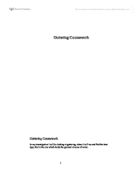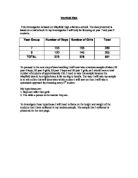Area=1/2absin θ
A= ½ x B/2 x B/2 x sin θ
A= (B2) sin θ
θ’s value will lie between the two extremes of 0∧ and 180∧. The only variable will be sinθ. The maximum of sinθ = 0.
This occurs when θ=90∧ and is shown on the sine curve below.
∴maximum value= (B2)/8 x sin90∧
= (B2)/8 x 1
= (B2)/8
=0.125B2
I realise that this is a smaller area than that of the semi circle.
I can prove that the above figure is the maximum area by using differentiation. I already know the derivatives of y=sinθ and y=cosθ
y = sinθ y=cosθ
dy/dθ = cosθ dy/dθ = -sinθ
∴A= 0.125B2sinθ
dA/dθ = 0.125B2cosθ
At maximum area dA/dθ =0
∴0.125B2
Cosθ=0
θ=cos-10
θ=90∧
To prove this is a maximum I will find
d2A/dθ2
d2A/dθ2 = -0.125B2
When θ=90∧
d2A/dθ2 =-0.125B2sin90
=-0.125B2
∴since d2A/dθ2 has a negative value then the area I have is the maximum value.
Rectangular Cross Section
This will be the third cross sectional area I shall investigate.
Each side will be length “y” and the base will be B-2y
Area = x(B-2x)
A = Bx-2x2
Below is a sketch of the graph A= By-2y2
I realise from my maths knowledge that this is a quadratic expression. I also know that because it is a-x2.
Its shape will be . The graph will cross the axis where A=0.
∴Put A=0
Bx-2x2=0
x(Bx-2x)=0
x=0, B-2x=0
2x=B
x=B/2
Therefore the graph will cross the x axis at the values of 0 and B/2. Below is the sketch of my graph.
Due to the graph’s symmetry, the maximum area occurs half way between the two points 0 and B/2. This is the point B/4.
Maximum area = B/2 x B/4
= (B2)/8 = 0.125B2
I can now prove this by using differentiation.
A=Bx-2x2
dA/dx = B- 4x
At maximum point dA/dx = 0
∴B-4x=0
4x=0
x=B/4
To show this is maximum I will find d2A/dx2
d2A/dx2 = -4
Since d2A/dx2 is negative then the area is the maximum value when x =1/4. I have proved what I have found before. It is the same as triangular cross section but less that semi circular.
I notice that the maximum area of the rectangle is the same as that of the maximum area of the triangle. So it is still less than the area of the semi-circle.
I also have notice that the triangles and rectangles area is equal to half of the same square.
I will now investigate the cross sectional area of a trapezoid by “opening” up the sides of the rectangle.
Trapezoidal Cross Section
This time there are two variable; the length of side x and the angle θ which the sides make with the vertical.
For this I will use my measured value of the perimeter which is 18cm. The sides are “x”cm so the base is 18cm-2x.
I now intend to derive a formula for figuring out a formula to work out the area of the trapezoidal cross section.
Area of the trapezium = ½ x sum of sides x perpendicular distance between them.
A= ½ x (18-2x + 18 -2x +2b) x h
A= ½ x (36-4x+ 2b) x h
(18-2x+b) x h
I will try to put B and h in terms of the two variable X+ θ using trigonometry.
Sinθ= B/x Cos θ= h/x
B= xsinθ h= cos θ x
∴ A= (18-2x + xsin θ)(x cos θ)
Since there are two variables I will use a Microsoft Excel to work out the maximum possible area of the trapezoidal cross section.
I know that to find Sine using Microsoft Excel the angle will have to be in radians. I already know the formula needed to change it.
The spread sheet I made can be seen on one of the last pages of this booklet.
It can be seen that for the length 18cm the maximum area is 46.77cm2. This is possible when θ is 30o and the length of each side is 6cm.
.
I have also investigated the perimeters of two other trapezoidal shapes:
1) When the perimeter is 24cm the maximum area is 83.14cm2. This occurs when θ is 30o and each side is 8cm.
2) When the perimeter is 30cm the maximum area is 129.9cm2. This occurs when θ is 30oansd each side is 10cm.
From my investigation into trapezoidal shapes I have concluded that for to have the maximum area the sides have to be 1/3 of the perimeter and angle has to be 30o. I realise that for to have the maximum area the trapezium has to be half of a regular hexagon.
I will now put this into terms of my length “Bcm” so I can compare it to the other areas I have worked out.
When the perimeter is “Bcm” then the maximum area should occur when x= B/3 and θ= 30o
∴ The maximum area = (B-2x+xsin θ)(xcos θ)
= (B-2(B/3) + B/3 sin30)(B/3 cos30)
= (B- 2/3B+ 1/6B)(0.2887B)
= 0.1443B2
This is larger than the rectangular and triangular area but it is still less than the semi-circular area.
Throughout this investigation I have notices that the maximum areas of the rectangular, triangular and trapezoidal cross sections all occurred when they formed the shape of half a regular polygon.
This has given me the idea to investigate half regular polygons. I think that if I increase the number of sides the area of the polygons will get close to that of the semi circle but as they won’t be able to fully recreate the semi-circles curved perimeter they won’t surpass the area of the semi-circle.
Half Regular Polygons
I will now derive a formula for the area of a half regular polygon with sides “n” and perimeter of “B”
If the perimeter is B and there are n sides then the length of each side is B/n
I will divide the half regular polygon into n congruent triangles.
Area of 1 triangle = ½ bh
= ½ x B/n x h
= Bh/2n
∴ Area of half regular polygon = n x bh/2n
= Bh/2
= ½ Bh
I would like h to be in terms of n (number of sides).
Looking at one triangle:
tan θ = B/h
h tan θ= B/2n
∴h= B/2ntan θ
θ = 180/2n
θ=90/n
∴B/2ntan (90/n)
Area of ½ regular polygon= ½ Bh
= ½ B x B/(2n tan) (90/n)
= B2/ 4n tan (90/n)
I will double check my formula by using n=3 to find the area of a half regular hexagon which I already know from the cross sectional area of a trapezium.
A= B2/ (4(3) tan (90/3))
A= B2/(12tan 30)
A= 0.1443B2
This is the same area I got for the half regular hexagon so I know my formula works.
I will now use Microsoft Excel to record my results will see how the area increases as the number of sides increase for half regular polygons.
As I thought the area does get close to that of the semi circle as the sides increase but never exceeds it.
CONCLUSION: My hypothesis was correct, and the semi-circular guttering is the type which can hold the most water.








